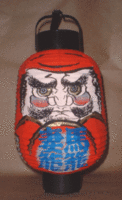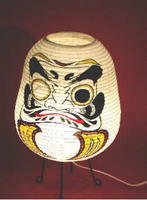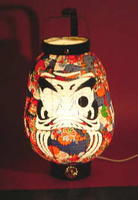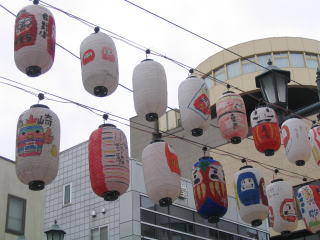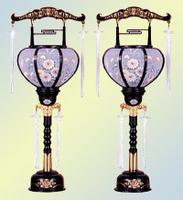:::::::::::::::::::::::::::::::::::::::::::::::::::::::::::::::::::::::::::::::::::::::::::::::::::::
DARUMA ... Additions 2010
Kanban kenchiku 看板建築 billboard architecture
signboard architecture
. . . . . and
Town Houses of Kyoto, Kyoto Machiya 京都町屋
Harimi はりみ paper dustpan
Tokaido 東海道五十三次
The 53 stations of the Tokaido
Fukuda Kodoojin 福田古道人 Fukuda Kodojin (1865-1944) Painter and Haiku Poet
Keeki だるまケーキ Daruma Cakes of all kinds - cake
Fue 笛 Flute, Daruma playing flute
Kawai Toshiaki 河合豊彰 and Origami Daruma 折り紙
Men お面不動明王 Masks with Fudo Myo-O A big collection !
Kasukabe Dolls 春日部張子 Daruma on a catfish, Watonai 和唐内 / 和藤内 Watoonai
Senjafuda 千社札 Shrine Tags
E-Tegami, etegami 絵手紙 <> Handpainted Letters and Postcards (like Haiga)
Taimadera 当麻寺 / 當麻寺 and the Taima Mandala 当麻曼荼羅図
Gion Festival (Gion matsuri) Kyoto, Japan
Daruma Sushi だるま 寿司
Tagami Kikusha 田上菊舎 Haiku poet and painter. (1753 - 1826)
Lodging, inn, guest house (hatago (旅籠, 旅篭))
Conch trumpet plant (horagai soo) Japan. Impatiens textorii. Jewelweed. all about the horagai conch trumpet and yamabushi
Sakaori no Miya and Yamato Takeru 酒折宮 . 日本武尊
Danjiri Matsuri Festivals だんじり祭り Autumn festivals
Nagoya matsuri 名古屋祭り Nagoya Festival
Otsu Matsuri 大津祭 Otsu Festival
Nijo Castle 二条城 (Nijoo-joo) Kyoto and the Shikidai Hall
Ninja 忍者 spies of the Edo period
Hatomugi cha はとむぎ ダルマ and dokudami cha. Job's tears tea.
Gosho Imperial Palace in Kyoto 京都御所 Kyoto Gosho
Hisui 翡翠 / ヒスイ jade and menoo 瑪瑙 agate
Ishida Mitsunari 石田三成 1560 - November 6, 1600. Samurai
Natori Shunsen 名取春仙 1886 - 1960. Hanga artist. and Ogiwara Seisensui 荻原井泉水
Oshaburi おしゃぶり teething ring Beissring, Schnuller
Nebuta Matsuri ねぶた祭 Nebuta Festival and Daruma Daishi Float
Shimizu Seifu (Seifuu) 清水清風 (1851 - 1913) Woodblock prints of Toys
Kama, Daruma kama ダルマ鎌 sickle called DARUMA
Roadside sanctuaries, wayside shrines (tsujidoo 辻堂) Tsujido
Xavier, Saint Francis Xavier, sei Sabieru 聖ザビエル
(1506 - 1552)
Kenkoo Daruma 健康だるま for your Health
Genki Daruma for your wellbeing 元気だるま
Moon Rabbit Daruma Plant ダルマ月兎耳 Kalanchoe tomentosa
.
KyunKyara きゅんキャラ K-On Figures
Yookan 羊羹 sweet bean jelly kurimushi yookan 栗蒸し羊羹 with chestnuts
Arukigami 歩行神 the God of Wandering with Basho and Issa
Sozorogami そぞろ神
Harahoge Jizoo はらほげ地蔵 Harahoge Jizo, Iki Island 壱岐
Date Masamune 伊達政宗 (1567 - 1636)
Benten, Benzaiten 弁天 / 弁財天
Kumade 熊手(くまで) "hand of a bear", lucky bamboo rake
okame-ichi おかめ市(おかめいち) market for masks of "o-kame"
hyottoko ひょっとこ Hyottoko and O-Kame おかめ【阿亀】, O-Tafuku おたふく【阿多福】
Kingyo 金魚 Goldfish named フクダルマ Fuku Daruma
Kanegasaki 金崎城 / 鐘ヶ崎城 and Basho in Tsuruga
Daruma Pilgrims
Ai 藍 indigo
Sanada himo 真田紐 Sanada-himo ribbon Shogun Sanada Daruma
Inden 印伝/ 印傳 deerskin products Yamanashi prefecture
Koshuu inden 甲州印傳(こうしゅういんでん)
yookai daruma 妖怪ダルマ Daruma as a monster
some are from the gegege no Kitaro manga
Darumappa Ten Exhibition だるまッパ展 April 2010
Nagai Yasuo 永井康夫 Laquer Tableware
Seruroido ningyoo セルロイド人形 celluloid dolls
セルロイド玩具 celluloid toys
Kiriko 切子だるま cut glass Edo Kiriko 江戸切子, Satsuma Kiriko 薩摩切子
Ikkyu Sojun 一休宗純 (1394-1481) Zen priest
Hachi 鉢 small pot
Gate (門 mon, kado) Temple gate (sanmon)
Miroku Bosatsu 弥勒菩薩 Maitreya
Shomen Kongo 青面金剛 Shoomen Kongoo
Kichijoten 吉祥天 Kichijooten (Lakshmi, Shri Mahadevi)
Idaten 韋駄天 (Skanda)
Daigensui, Taigen (Atavaka) 大元帥明王
Gigeiten 伎芸天 Daijizai Tennyo 大自在天女
. . . and Daijizai Ten 大自在天 (Shiva)
Pagoda and Stupa (too 塔 )
Fugen Bosatsu (Samantabhadra) 普賢菩薩 and the White Elephant
Eta and Burakumin 穢多 (えた) / 部落民 the "Untouchables" of Japan
Sacred Symbols in Profane Japan Exhibition, Scholten Japanese Art
Utasebune 打瀬船 fishing boat for shrimp
Yamato Province (大和国 Yamato no Kuni)
Fishing Methods in Japan
Oshoo Daruma だるま和尚 Osho, the Priest Daruma
Takita Sakae, actor and carver 滝田栄 Fudo Myo-O statue
Samekawa Jinja Misogi 佐女川神社
Cold Water Ablutions at Shrine Samekawa
Hokkaido
.
Hiraizumi, temple Motsu-Ji and Chuson-Ji, the Fujiwara clan
平泉、毛越寺、中尊寺, 藤原 (Mootsuuji, Chuusonji)
Kishibojin 鬼子母神 at temple Miidera 千団子祭 festival of the one thousand dango
Tagai Kansho (Tagai Kanshoo 互井観章) "Mr Happiness" / ハピネス観章 the rapping monk of temple Kyo-O-Ji 経王寺, Tokyo
. . . Kigo with Daruma himself !
gookaku 合格(ごうかく)pass an examination with the help of Daruma san
Nichiren 日蓮 Saint Nichiren (1222 - 1282)
Goshiki 五色 The Five Colors of Buddhism
Banzai Daruma by Mauricio Eiji
Wall sticker, wallpaper ウォールステッカーだるま
Hakobi Daruma hakobi だるま運び Carry-around Daruma. Game
Urushi 漆工芸 laquer and Daruma : Introduction
Fude Daruma 筆だるま / Daruma Fude だるま筆 Daruma fude as a pen
Daruma mikan 達磨蜜柑(だるまみかん)mikan named Daruma
Matsuyama no Hime Daruma 松山の姫だるま Princess Daruma from Matsuyama
Jimotsu 持物 What is Daruma holding?
Me-ire - Painting Eyes for Daruma 達磨の目入れ Daruma and his EYES
Sunafumi 砂踏み <> O-Sunafumi, osunafumi, Stepping on Sacred Sand
Temple Jindai-Ji and the Ajikan meditation 深大寺の達磨市 to 阿字観
Daruma Days, book by Terry Watada
WHO is Daruma ? Introduction
Goma aburi-ki 胡麻あぶり器 Sesame seed roasting pot Type of Horoku (hooroku)
Curry from GLICO グリコカレー / glico カレー職人 Gookaku 合格 to pass the examination
Hachiman and Hachiman Shrine festivals Yahata Festivals
Tsurugaoka Hachiman-gū (鶴岡八幡宮)
Iwashimizu Hachiman-gū (石清水八幡宮)
.
Miwa, Omiwa Jinja 大三輪神社 and Mount Miwa三輪山. Mimoro yama 三諸山. Nara
Bonten 梵天 Brahma
Daikokuten, Daikoku 大黒天
Benten, Suiten and water deities 弁天、水天
Sumiyoshi Myoojin 住吉明神 Sumiyoshi Myojin and Sumiyoshi Shrines in Japan 住吉神社 Sumiyoshi Jinja
Gifu Hashima Train Station and Enku 岐阜羽島
Sakasa Jizo さかさ地蔵 "upside down" Jizo
Eigen-ji 永源寺 Temple and 寂室元光 Jakushitsu Genko
Daruma Sunset (Daruma yuuhi だるま夕日)
Sakamoto Royma (Ryuma) 坂本龍馬 (1836 - 1867). Ryomaden 竜馬伝
:::::::::::::::::::::::::::::::::::::::::::::::::::::::::::::::::::::::::::::::::::::::::::::::::::::
ALL ... Latest Additions from 2009
ALL ... Latest Additions from 2008
ALL ... Latest Additions from 2007
ALL ... Latest Additions from 2006
..... Latest Additions from 2005 are here:
http://darumasan.blogspot.com/2005/12/2005-latest-additions.html
:::::::::::::::::::::::::::::::::::::::::::::::::::::::::::::::::::::::::::::::::::::::::::::::::::::
To the Daruma Museum ABC Index
http://darumasan.blogspot.com/
World Kigo Database
Daruma Museum Waitinglist
. . . . . . . . . . . .Daruma Museum Archives since 2007
Daruma Digest January 2005
:::::::::::::::::::::::::::::::::::::::::::::::::::::::::::::::::::::::::::::::::::::::::::::::::::::

[ . BACK to DARUMA MUSEUM TOP . ]
:::::::::::::::::::::::::::::::::::::::::::::::::::::::::::::::::::::::::::::::::::::::::::::::::::::




























